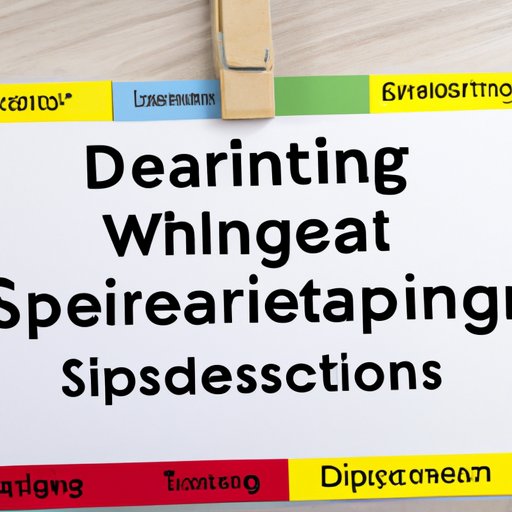
Introduction
Specific Learning Disabilities (SLDs) are a complex and challenging issue for children and adults alike. These disabilities can make it difficult for individuals to learn and process information and may affect their academic and social progress. This article aims to provide a comprehensive guide covering all aspects of SLDs, from what they are, how to diagnose them, and how to best support individuals affected by them.
Understanding Specific Learning Disabilities: A Comprehensive Guide
SLD is an umbrella term used to describe a range of conditions that affect an individual’s ability to learn, read, write, speak, listen, and process information. Unlike other disabilities like intellectual disabilities or physical disabilities, SLDs affect specific areas of functioning while still allowing the individual to perform other tasks well.
There are several different categories of SLDs, including dyslexia, dysgraphia, dyscalculia, oral language disorders, and nonverbal learning disabilities. Each of these has its own set of challenges and characteristics that make it challenging for individuals to process and retain information.
SLDs can manifest in different ways in different individuals, but some common signs and symptoms include reading and spelling difficulties, difficulties with memory and organization, difficulty understanding instructions, difficulty with mathematical concepts, and challenges with social communication and language processing.
There are many resources and support options available for individuals affected by SLDs, including special education programs, instructional technology, and individualized learning plans tailored to fit the needs of each person.
Advocating for Children with Specific Learning Disabilities
Advocating for children with SLDs is crucial for ensuring they receive the proper support and resources they need to succeed academically and personally. Strategies for advocating for children with SLDs include working closely with educators, developing and implementing individualized learning plans (IEPs), and partnering with community organizations and support groups.
Parents, educators, and caregivers also need to navigate the education system to ensure children with SLDs can receive the support and accommodations they need. It is essential to understand the Disability Education Act and the protections it provides for children with disabilities, as well as the resources available through the Individuals with Disabilities Education Act.
It is also vital to support children with SLDs by providing a supportive and empowering environment at home. This can include offering resources like books on SLDs, using positive reinforcement, and promoting healthy communication and emotional support.
Diagnosing Specific Learning Disabilities: What You Need to Know
Diagnosing SLDs can be challenging, and it is important to find a qualified and experienced professional to help with the process. Several assessments may be used to diagnose SLDs, including intelligence tests, academic achievement tests, and cognitive processing tests.
Early diagnosis and effective treatment are essential to support individuals with SLDs. A proper diagnosis can help individuals and their families access support programs, educational accommodations, and other resources to help them overcome their challenges.
Overcoming Challenges: Stories of Success from People with Specific Learning Disabilities
There are many inspiring stories of individuals who have overcome their SLDs and achieved personal and/or professional success. Strategies used to overcome challenges include embracing individual learning styles, using assistive technology, developing coping mechanisms, building a strong support system, and working closely with educators and healthcare professionals.
These stories serve as a reminder that having an SLD does not have to hold individuals back from success. With the right resources, tools, and support, individuals with SLDs can achieve their goals and reach their full potential.
Technological Tools for Students with Specific Learning Disabilities
Technological tools can be an excellent resource for students with SLDs to help them overcome their challenges and succeed academically. Assistive devices like speech-to-text software, audiobooks, and specialized apps can all help students to learn and communicate in ways that work with their specific learning style.
Other strategies like color-coding materials, using graphic organizers and visually appealing diagrams can help students to organize and retain information easier.
Conclusion
Understanding Specific Learning Disabilities is essential to provide the right support and accommodations to individuals struggling with SLDs. Advocating for children with SLDs and finding support resources is crucial to ensure they have the best chance of success, both academically and socially. With the right tools and support, individuals with SLDs can overcome even the most significant challenges and achieve their goals.
For those who are currently struggling with SLDs, know that there are resources and support options available to help you overcome your challenges. Never give up hope, as success is possible with the right support and determination.




